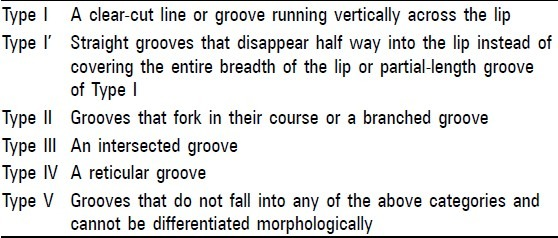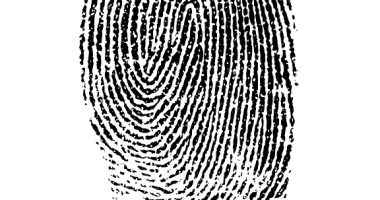Lip Prints are the characteristics pattern formed by the numerous elevations and depressions on the external surface of the lip of a person. The various patterns that have been observed by researchers are vertical, intersected, branched, reticular and undetermined.
The pattern of wrinkles and grooves on the labial mucosa (known an sulci labiorum ) form the lip print, and the study of lip prints is called as Cheiloscopy.
Thus, in the field of forensic science, Cheiloscopy can be defined as the method for scientific identification of a person based on peculiar organization of lines that are present on the red part of the lips. The use of lip print recommended for identification purposes was first suggested by Edmond Locard in 1932, who also gave the classic “Locard’s Exchange Principle that has been aiding the forensic investigation ever since.
The principle behind lip print being used as a verification tool in investigating a crime is that lip prints remain uniform throughout the lifetime of a person and no two persons have been found to exist exactly same pattern of lip print. Lip print, impression evidence like fingerprints, can be found at the crime scene at various places like cutlery or crockery items, windows, door glass, photographs, letters, cigarette buds and on some food products like apple (along with the bite mark).
The appearance of lip prints has been widely seen in cases of murders, rapes and burglaries. Since the ongoing advancement in the modern techniques of crime detection has forewarned the notorious smart criminals to take precautions to escape the chance of leaving behind any kind of identification mark specially fingerprint) at the crime scene, the print has proved to be good supportive evidence to verify the presence of a person, the conditions necessary for imprinting the impression of lip such as consuming drink or using tissues).
FORMS OF LIP PRINTS THAT ARE FOUND ON CRIME SCENE
There are mainly 3 types of lip prints that are most commonly present on the crime scene are:
- VISIBLE LIP PRINTS: the visible lip prints are those prints that are visible to the human eye and does not require further development techniques. They are mainly present on body parts or clothes.
- LATENT LIP PRINTS: those prints which are not visible to our naked eyes and require development techniques to make them visualization.
- 3D LIP PRINTS: those prints which are present on soft wax or butter or on the fruits. They also require some development techniques to make clearly visible.
CLASSIFICATION OF LIP PRINTS
The most acceptable system of classification, on which the Renaud classification system is also based, was given by Suzuki and Tsuchihashi in year 1971. This system was based on six different types of characteristic grooves found in Lip print which are described in the table below:

Another classification was given by Renaud in year 1973 considered as one complete classification. Here, he suggested to divide the lips in two halves (Left and Right) a elaborated using alphabets-capital and small letters. Capital letters described the upper lip left (1) and right lip (R) and small letter was used to classify the grooves. Other way round, the lower lip in described using small letters (and) and the grooves were designated as with capital letters.
There were 10 types of grooves that were identified namely complete vertical (A), incomplete vertical (B), complete bifurcated (C), incomplete bifurcated (D), complete branched (E), incomplete branched (F), reticular pattern (G), X or comma pattern (10. horizontal pattern (I), and other patterns like triangle, ellipse (J).
- Recording of Lip Print-Lip print impressions are recorded from suspects and innocents for criminal as well as civil purposes. To make the record, the lips must be first cleaned with a wet cotton thoroughly so that dust or any other material does not disturb the impression of lips. Following are the different method used for recording tip impressions:
- Photography The lip prints are photographed accurately with the help of an ABFO N. 2 Scale (American Board of Forensic Odontologists) and under proper lighting and shall be of accurately natural size. The lighting should be angled in such a direction that the contrast between the dark and white areas in accentuated.
- Using Transferring Medium – The authors credited Williams for their suggestion that multiple sets of lip prints can be taken after applying a transfer medium like lipstick. Many prints are taken in order to ensure that all the parts of the lip are imprinted. A sufficiently large amount of transfer medium is applied on the lip and the person is then made to press his/her lips against the recording surface like glass sheet, matte or glossy paper. etc. The prints are taken till the transfer medium is exhausted to the limit of giving incomplete prints. Another way to record such prints is with the means of cellophane tape.
- Using Fingerprinting Ink – This method for collecting lip print has been first proposed by Suzuki and Tsuchihashi in 1970, although it was already being used to collect finger print impressions. Here, the special paper milled on the roller finger printer was directly applied to the lips of the subject and then are traced on a cellophane paper. In detail, lips of the subject is covered with a thin layer of moisturizing balm or cream and is al mounted on the lips and is gently pressed. This latest lip print is visualized with the help of ferromagnetic powder and finally fixed on a transparent foil. But this method is not much encouraged due to chances of smudging or distortion of lip prints because of uneven pressure applied. Also, there is a high possibility of getting incomplete prints, missing the end of the cuspid.
- Development of Lip Prints – Agarwal, Dwivedi and Khare in their work “Lates Lip Print: A New Possibility have excellently described the various techniques used to develop latest lip prints. They have suggested that the development of lip prints depends on various following factors.
- The Pre-transfer conditions that affect the lip print impression is age, gender, occupation, disease and any other material like lipstick is applied
- The transfer conditions determine whether the impression will be left or not including the conditions of surface like its area, curvature, texture, etc. and the pressure applied to imprint the print during contact.
- The post transfer conditions are generally the external environmental factors like water, temperature, humidity, etc. affecting the quality of lip print on a surface.
Latent Prints are developed by various methods which are basically established on the fact the sweat and sebaceous secretions of body (print residue) react with the compound of the methodology that makes the print visible and identifiable. The different methods have been discussed.
• Fingerprint Powder-The development principle of dusting fingerprint powder on the lip print is the adherence affinity of the powder to the moisture and oil residue deposit of the friction ridge (furrows) of the lip print.
On non-porous surfaces, the powder is applied with the help of a soft brush so that the latest print residue is not disturbed or damaged. The strokes shall be uniform and light resembling free hand paintings Carbon Black, Lamp Black Kaolin. Tic. Metal Flake Powder (made from Aluminum, Zinc, Copper, Brass, Stainless Steel, Cobalt, Iron and Nickel) and Dolomite are the various types of powders that are used to develop lip prints. The conventional brush used to dust this powder are generally made with animal hair, feathers or fiberglass elements.
Apart from the convention dusting powders, Magna powder or Magnetic powder is also used nowadays. The magnetic powder can either be light, dark or fluorescent and is applied with the help of no-bristle rod that has a magnetized rod. These powders have ferromagnetic properties of iron mixed with pigments. The magna brush is dipped into the magnetic powder which picks up the powder. particles and forming a brush of its own. The powder is then gently rolled over the latent print to develop it.
• Lysochrome Dyes – Lysochrome dyes are the compounds that shows chromogenic property upon contact dissolution with fats (fatty acid) that are present in lip prints. One of the most common Lysochrome dye is Sudan Black, which has been mentioned in various literature for developing latent fingerprints. Sometimes, fluorescent agent is required to visualize the print in case the color of the surface is similar to that of the lip print.
The names of other methodologies that can be used to develop latent lip print development that are similar to the techniques used to develop latent fingerprint impressions are Cyanoacrylate / Super Glue Fuming Method, Ninhydrin Meth Indanedione Method, 5-MethylthioNintydrin Method (5-MTS). DEO Method, Vac Deposition (VMD).
- Examination of Lip Print-Kinnan et al in their study “Cheiloscopy – A Vital Tool in Crime Investigation” has described that although, lip prints can be reliable forensic evidence to support and even corroborate an investigation, but there are some complications associated with lip print impression evidence. Since, the lower lip is movable, thus due to different pressure and direction, lip prints of variable site can be obtained, though the pattern will not change. Also, other abnormal and unnatural conditions liked chapped or inflamed lips, morphological abnormalities (developmental disturbance, ulcers, infections, cysts, etc.) may affect the pattern of the lips and most importantly, absence of ante mortem data of lip prints complicates or even curbs the further investigation which in other case would have proceeded and may have led to a conclusion as well.
Various studies have been conducted and are being carried out to extract the features of lip prints that prove viable and useful for examination and identification of the lip print evidence. Since lip is the visible and sensitive pan of face, lips have been considered for biometric identification system and various system algorithms have been proposed by researchers. The lip print extraction systems work on recognizing the characteristic features of the lip print.
for more updates, subscribe to our blog.






